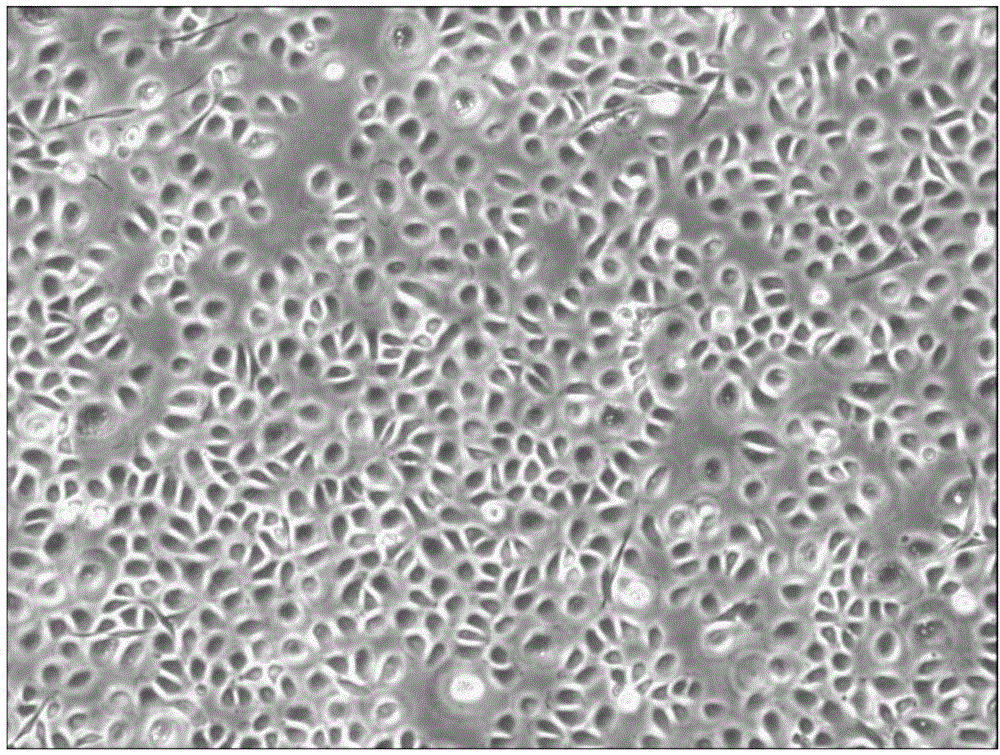Novel method for in-vitro separated culture of human epidermal cells
An epidermal cell, separation and culture technology, applied in the field of histology, can solve the problems of difficult to grasp the degree of 3T3 cell inactivation, difficult to observe the culture process, easy corruption of the medium, etc., to achieve high clone formation efficiency, good cell condition, inhibition The effect of pollution
- Summary
- Abstract
- Description
- Claims
- Application Information
AI Technical Summary
Problems solved by technology
Method used
Image
Examples
example 1
[0027] Example 1: Successful isolation and expansion of human epidermal cells from adult breast skin
[0028] (1) Materials and methods
[0029] Tissue: Adult normal chest skin (including dermis and epidermis) discarded by hospital surgery, about 0.5cm 2 .
[0030] Cell culture medium: CNT07
[0031] (2) Cell isolation and culture:
[0032] a) The tissue is refrigerated in F12 culture medium and transported to the laboratory, and weighed. Rinse with 70% alcohol, then soak in PBS containing 200U / ml penicillin and streptomycin for 5 minutes twice.
[0033] b) Mince the tissue completely with a scalpel, observe the condition of the tissue at all times, and add PBS if it is too dry. Add 20ml of digestion solution (PBS containing 2.5mg / ml collagenase and 2.5mg / ml dispase) per 1g of tissue into a centrifuge tube, mix well, digest in a water bath at 37°C for 90-120min with shaking, and then add to a final concentration of 0.05% Continue to digest with trypsin for 30 minutes, an...
example 2
[0041] Example 2: Using human head skin tissue, successfully isolated and expanded human head skin epidermal cells
[0042] (1) Materials and methods
[0043] Tissue: Normal head skin (including dermis and epidermis) of embryos discarded during hospital operations, about 1cm 2 .
[0044] Cell culture medium: CNT07
[0045] (2) Cell separation and cultivation: the method is the same as in Example 1.
[0046] (3) Results: The isolated cell clones are more, easy to adhere to the wall, and can be quickly connected into sheets in the culture flask. The cells are in the shape of "paving stones". status and proliferative capacity.
example 3
[0047] Example 3: the human epidermal cells separated by the method of the present invention are applied to making artificial skin
[0048] (1) Material: BD collagen
[0049] (2) cells: human epidermal cells and human epidermal cells obtained in Example 1
[0050] (3) Method:
[0051] a) Prepare a cell-free collagen layer on ice, spread it in the nested well of a 6-well cell culture plate, and let it stand at room temperature for 20 minutes to make it gel.
[0052] b) The cultured dermal cells were digested, mixed with the glue mixed matrix, spread on the acellular collagen layer and cultured for 30 minutes.
[0053] c) adding dermal cell culture medium and culturing for 3 days.
[0054] d) Remove the dermal cell culture medium, digest the isolated and cultured human epidermal cells and lay them in the center of the collagen glue, let stand at room temperature for 15 minutes to allow the cells to adhere to the wall, and then cultivate in an incubator for 30-60 minutes.
[...
PUM
 Login to View More
Login to View More Abstract
Description
Claims
Application Information
 Login to View More
Login to View More - R&D
- Intellectual Property
- Life Sciences
- Materials
- Tech Scout
- Unparalleled Data Quality
- Higher Quality Content
- 60% Fewer Hallucinations
Browse by: Latest US Patents, China's latest patents, Technical Efficacy Thesaurus, Application Domain, Technology Topic, Popular Technical Reports.
© 2025 PatSnap. All rights reserved.Legal|Privacy policy|Modern Slavery Act Transparency Statement|Sitemap|About US| Contact US: help@patsnap.com

